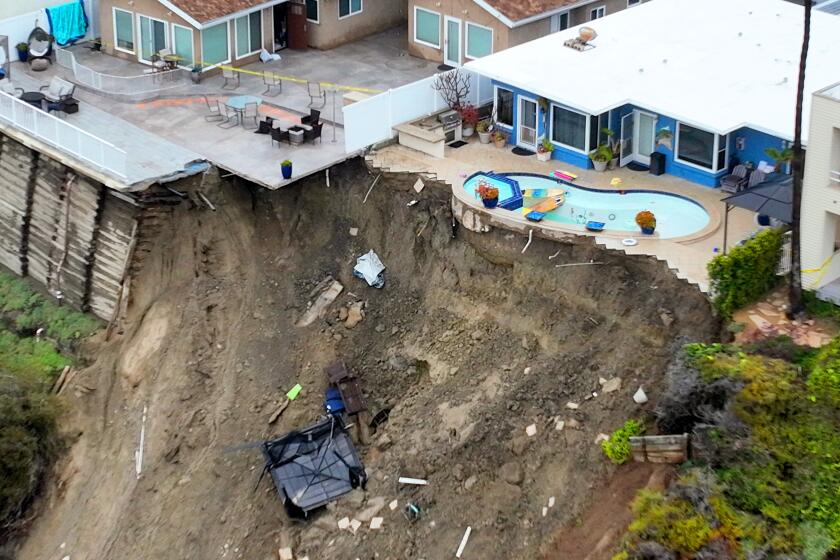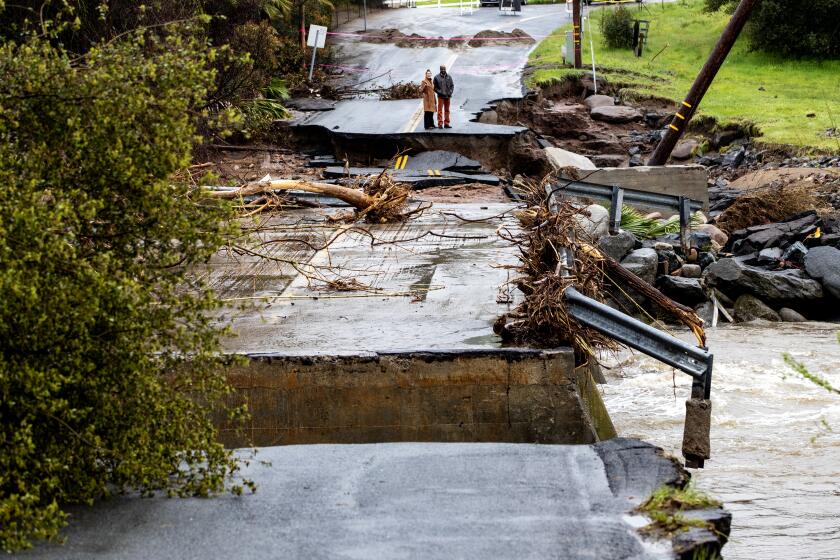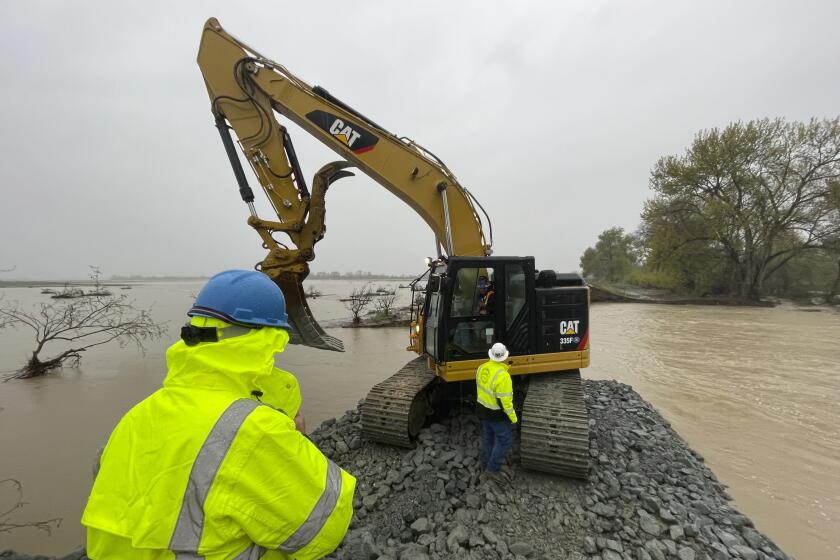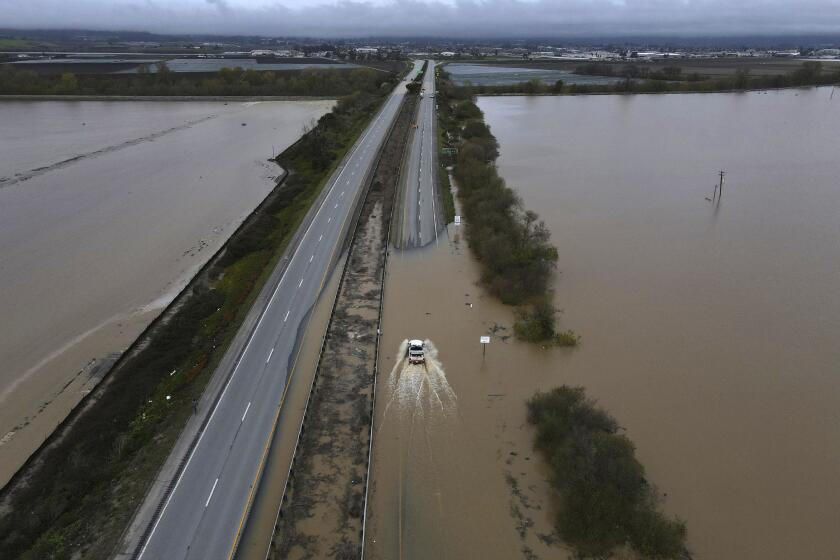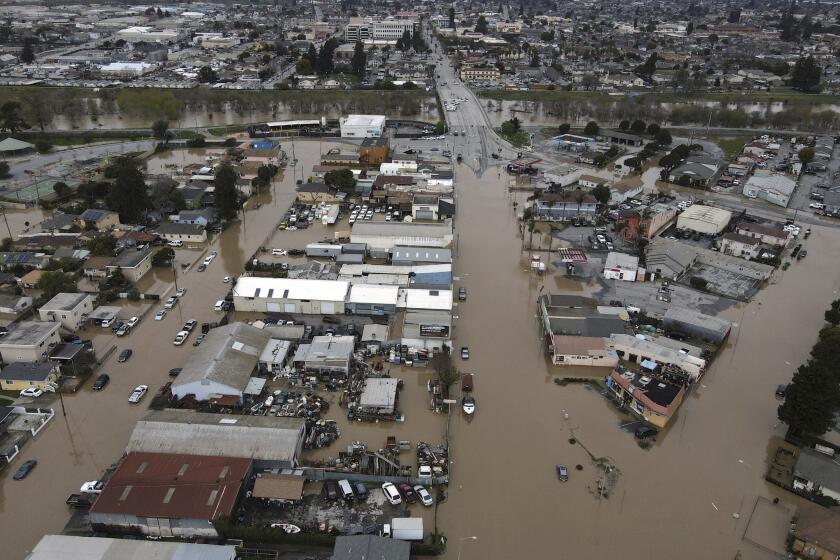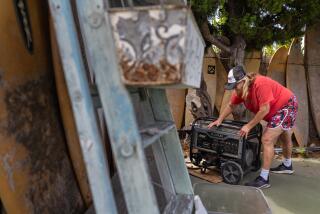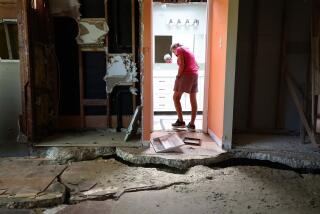Residents left in flooded California farm town feel ‘abandoned’ as levees fail
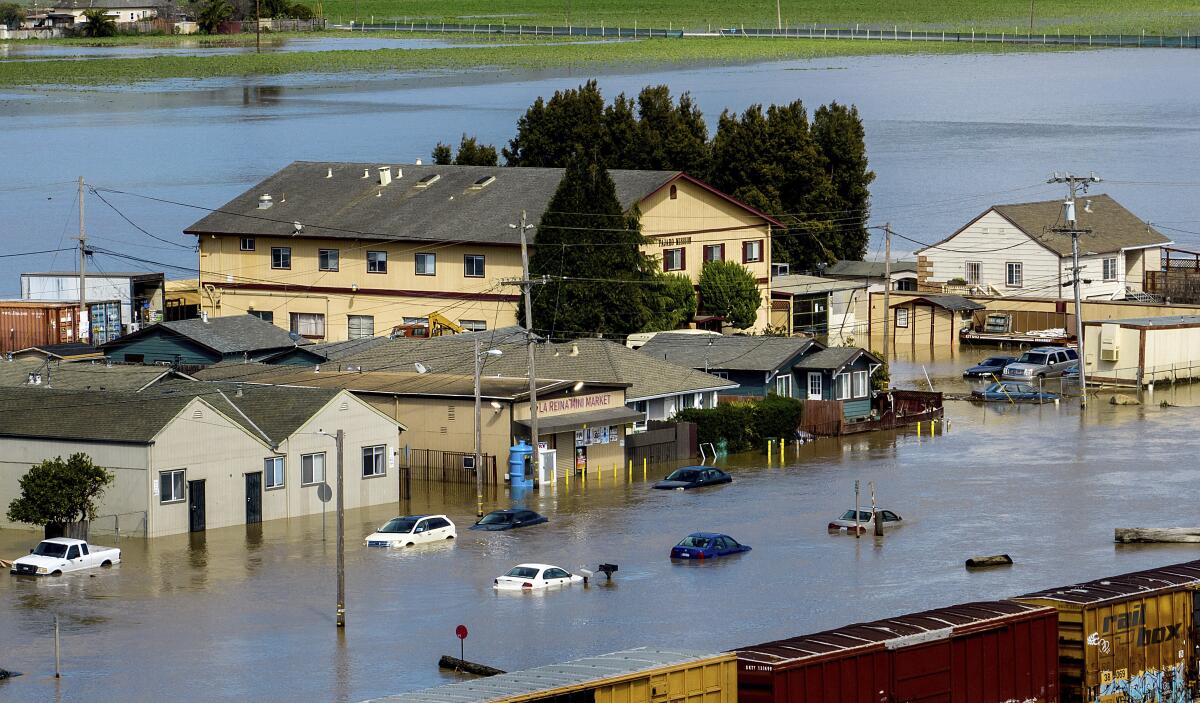
PAJARO, Calif. — Dora Alvarez stood on the balcony of her two-story apartment building Tuesday, holding a garden hose next to a rain gutter and steering the water toward recycling bins below for her family to use after boiling it.
“As long as they don’t shut the gas off, we’ll be OK,” she said.
Alvarez, 54, and her family were among the residents who chose not to evacuate Pajaro, the small migrant town that flooded when a levee on the Pajaro River failed late Friday, forcing hundreds of people to flee their homes.
“I know some people criticize us for not leaving, but the flooding danger isn’t here, it’s somewhere else,” Alvarez said, pointing south toward Salinas Road, which was submerged in water.
California continues to deal with damage from March storms: surging rivers, mudslides, breached levees and displacement in flooded towns.
Standing nearby, her neighbor Karla Loreto, 35, nodded in agreement.
“We’re also not going to be wandering around in search of danger,” Loreto said.
The town has in many ways become ground zero for the latest atmospheric river storm walloping California, the 11th of the season so far.
The storm has dropped even more rain and snow on the beleaguered state and sent thousands of residents racing from rising waters. By Tuesday evening, about 336,000 households were without power, and 70 flood watches and warnings were in effect.
More than a dozen locations along major rivers were overflowing as the storm moved south across California. About 336,000 people were without power.
Pajaro — a small town of about 3,000 people, many of them migrant farmworkers — may not recover for a long time.
“Areas that were flooded and remain flooded are still under an evacuation order, so therefore it’s not going to be a matter of days,” Nicholas Pasculli, a Monterey County spokesperson, said during a news briefing. “We want people to get back into their homes as soon as possible, and we’re going to do whatever we can to make that happen, but there’s going to be cases, without a doubt, that people will not be able to return to some of their homes.”
The town appeared lifeless Tuesday. Sandbags sat at the entrances of bars, beauty salons and meat markets. Around the area, streets had turned into miniature lakes. The water covered the tires of parked cars and gushed from underneath manhole coverings. Potatoes, lemons and food packaging lay on streets where the water had receded.
Sheriff’s cruisers and the National Guard patrolled as television reporters stood by flooded areas for news updates.
Officials said flooding wasn’t the only risk in the area. Major utility lines run through the levee under Highway 1, and a wastewater treatment facility is downstream.
“If the water continues to erode through the levee such that it reenters the river system … it could overwhelm the river system downstream of Highway 1,” where the wastewater treatment plant for Watsonville sits, said Mark Strudley, executive director of the Pajaro Regional Flood Management Agency.
If the water overtops or seeps through the levee, Strudley said, “we stand to destroy parts of the plant and may end up releasing untreated sewage to the floodplain, to the river and then ultimately to the Monterey Bay.”
Water flowing through a gap under Highway 1 is eroding the levee from outside the river channel, officials said as they consider emergency measures to prevent more catastrophic flooding.
Many in Pajaro remain under “do not drink” orders as there is no potable water because of the floods, according to Monterey County Undersheriff Keith Boyd. That includes one school, two mobile home parks and about 800 homes.
Despite the treacherous conditions in Pajaro, many families declined to leave because some residents who were evacuated in January returned to find that their homes had been broken into, Alvarez said.
She stayed behind this time in part because of her husband’s health. He has liver cancer and must see his doctor once a week for chemotherapy; his next appointment is Sunday.
“COVID poses a threat to him,” she said. “We can’t be in a shelter right now, not with his immune system being so weak. It’s better for us to be here in our own home, sleeping in our beds and eating the food we have in our fridge.”
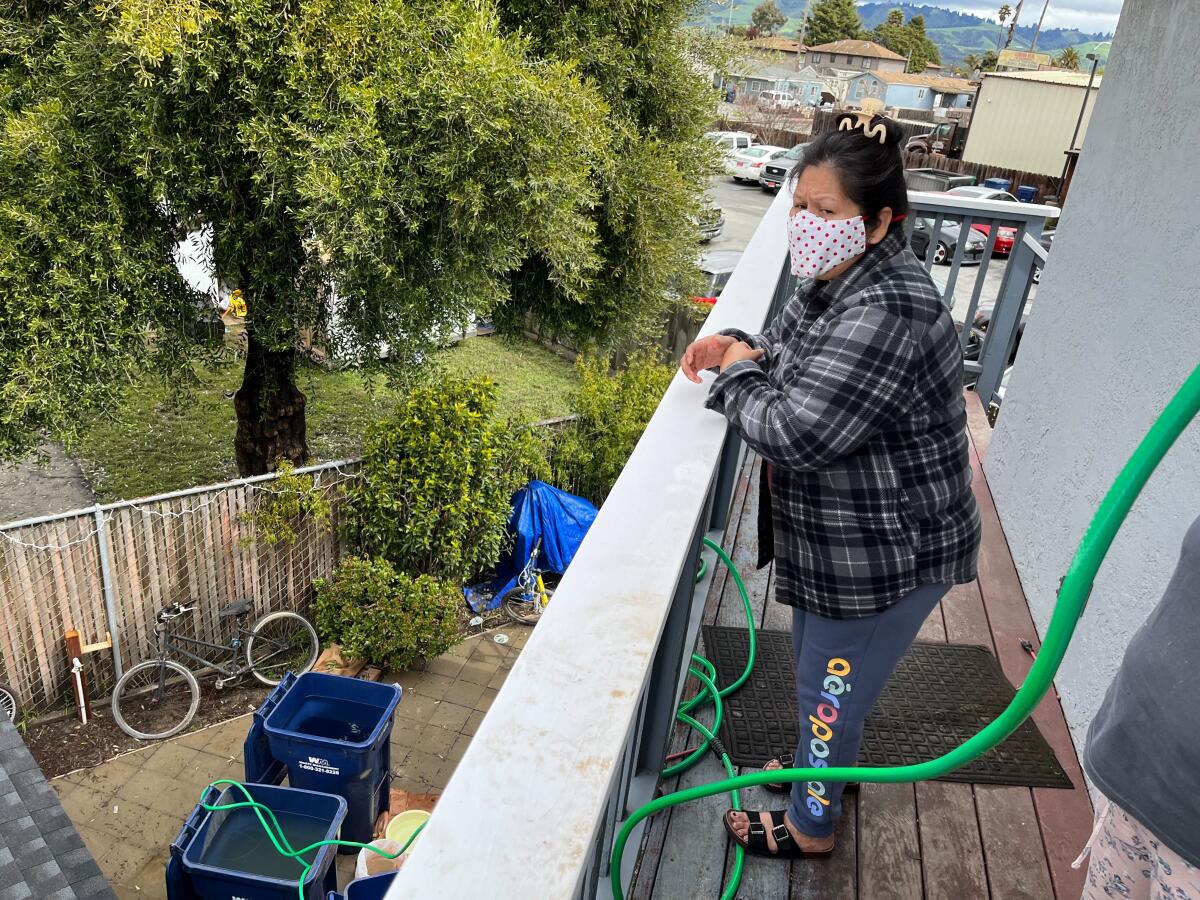
Alvarez said the flooding illustrated how Pajaro is often viewed by people from outside.
“The counties are willing to let this part of town get flooded,” Alvarez said.
Officials knew for decades that Pajaro was vulnerable but did not prioritize levee repairs in part because they believed it did not make financial sense to protect the low-income area, interviews and records show.
After a 1995 flood that killed two people and caused up to $95 million in economic damage, officials said they would address the problem, Alvarez recalled. They never did.
“We are the most hardworking people and we help this economy,” she said.
Loreto, her neighbor, agreed.
“We feel abandoned sometimes,” Loreto said. “Ever since I moved here, I’ve always heard about the 1995 flooding and this view that this part of town is so bad and extremely poor.”
She pointed to Watsonville, across the river in Santa Cruz County, and said that side was “lo mas nice” — the nicest part.
An incoming storm threatens to overflow the swollen Salinas River, imperiling the lives of farmworkers and crops and triggering evacuations.
The women said that because their community sits between Santa Cruz and Monterey counties, they feel forgotten and that neither county is willing to help.
It’s not an uncommon view in Pajaro.
Florencia Rios, 48, and her husband said they had heard about what happened during the 1995 flood.
For years, experts had been warning Monterey and Santa Cruz County that the levee along the Pajaro River could fail.
“It was made clear to me that this side of town isn’t worth much in terms of businesses, so the river is allowed to flood this town,” Rios said, gazing at Watsonville. “It feels like they have more resources there.”
“You can definitely see the difference,” said her husband, Enrique Olvera, 47.
The couple worried about what would come next — whether they will receive assistance, when there will be work. They have no money saved up and used whatever they had left to pay the March rent.
“We don’t even know where to seek help,” Olvera said. “We just need a little help, some food and water at the very least.”
Adding to the challenge is last week’s levee breach, which continues to put pressure on Pajaro and on nearby Watsonville as the Pajaro River swells from the storm.
County and state officials have been working to stabilize the about 350-foot breach by laying rocks and boulders to prevent it from getting larger, but there is still no official timeline for when it will be fixed.
“It’s been a very challenging site; conditions are very challenging,” Monterey County water resources engineer Shaunna Murray said during the briefing. “We have a small gap that needs to be stabilized. It’s a fairly deep area and challenging to access.”
Once the levee is stabilized, it will “take a couple of weeks to raise the levee repair and make it impermeable to water,” she said.
Officials were considering “manually breaching a section to relieve pressure,” said Zach Friend, a Santa Cruz County supervisor whose district includes portions of Watsonville, which is now threatened by the swelling Pajaro River.
The Pajaro River levee failure points to hazards that California has yet to address in many areas where communities are vulnerable, experts say.
The location of the gap in the middle of Highway 1 across a shallow bridge would make plugging it difficult, Strudley said, adding that officials have three options.
“One thing you can do is open up the levee downstream of that point — a little ways downstream, but upstream of the wastewater treatment plant — to let the water back out onto the floodplain,” Strudley said.
The second option “is actually opening up Highway 1. Basically cutting through Highway 1 and the low spot, which is to the south of the river, and letting the water out of the floodplain.”
The last option, he said, is to do nothing, which could suffice because the storm didn’t hit as hard as expected. A decision was likely going to be made late Tuesday.
As the floodwaters’ threat mounted in Pajaro, Rios and Olvera said they feared leaving because they’d been told they wouldn’t be allowed back in. Without money or means of getting to evacuation shelters, they said, they would be in an even worse position.
They said they weren’t alone: At least six families with children face the same challenge they do.
Alvarez, meanwhile, glanced over at two sheriff’s cruisers parked in the middle of the road near a bridge. She couldn’t understand why they would not let residents go in and out to purchase water and food — or, at the very least, why they couldn’t provide that to them.
“I’m from Mexico,” she said. “We’re used to dealing with disasters there. We know how to survive, we just need a little support.”
Alvarez arrived from Mexico two years before Pajaro flooded in 1995.
“It took two months to return home,” she said. “Two months — imagine coming back home and having to throw away all the food you had purchased and having no work?”
These recent storms felt worse, she said. The strawberries, cabbage and broccoli grown in the region were probably destroyed. Work would disappear again.
Loreto glanced down at the parking lot below.
“I work at the gas station behind this building,” she said, pointing with her thumb. “I don’t know when they’ll open that gas station.”
Vives reported from Pajaro, Rust from Menlo Park, and Smith from Los Angeles.
More to Read
Sign up for Essential California
The most important California stories and recommendations in your inbox every morning.
You may occasionally receive promotional content from the Los Angeles Times.
